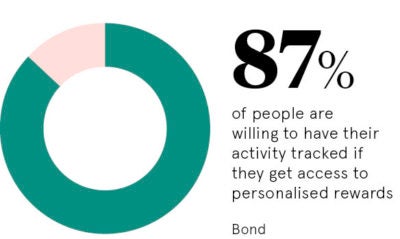You can download the full Customer Experience & Loyalty report here.
Companies in the B2C space have long understood the importance of effectively rewarding customers for their loyalty. But many B2B brands still believe that sending a Christmas hamper or bottle of champagne to long-term clients is enough to thank them for their long-term commitment.
While these types of gifts are not unwelcome, the advent of advanced data analytics, alongside several other innovative technologies, has made it possible for even small companies to better understand their clients and learn exactly what they want.
The future of rewarding loyalty will be underpinned by technological tools that empower staff to give customers exactly what they need, when they want it
Customers, too, are increasingly interested in being rewarded for showing loyalty. According to ‘The Loyalty Report 2018’, published by customer engagement agency Bond, a huge majority of people (87 per cent) say they are willing to have their activity tracked, if they get access to personalised rewards.
B2B brands can ensure their data collection is delivering value to their customers by using it to create a consistent omni-channel experience. Utilising data to engage customers on an emotional level can add value to the service offered to clients and, ultimately, make them more likely to remain loyal. Without detailed customer data it’s not possible to provide the most personalised rewards, insights, service and assistance during the entire customer journey.
A human element is still important to achieve a positive result for B2B loyalty programmes, but the future of rewarding loyalty will be underpinned by technological tools that empower staff to give customers exactly what they need, when they want it.
 Accurately measuring B2B customer loyalty can be difficult as it’s hard to discern what activities are directly due to loyalty and which are, for example, related to competitive prices or offers. One of the most effective and obvious ways to calculate customer loyalty is the repeat customer rate (RCR). If a customer has been purchasing the same product every month for the past 10 years, this information can be used to access the success of new loyalty initiatives.
Accurately measuring B2B customer loyalty can be difficult as it’s hard to discern what activities are directly due to loyalty and which are, for example, related to competitive prices or offers. One of the most effective and obvious ways to calculate customer loyalty is the repeat customer rate (RCR). If a customer has been purchasing the same product every month for the past 10 years, this information can be used to access the success of new loyalty initiatives.
Using this rate is a solid baseline for quantifying loyalty but by joining the customer lifetime value (CLV) with RCR can give companies a deeper insight into the different segments of customers they are trying to reward. Clients that are both high-spenders and regular customers should be rewarded in different ways than low-value, regular customers, meaning the need to measure total spend and purchase frequency are highly important.
Perhaps the single most relevant metric to measure customer loyalty is the Net Promoter Score (NPS), which is the likelihood of the customer to recommend a company’s products or services to their colleagues. Unlike the B2C space, where individual needs are often the primary purchase consideration, B2B purchasers must factor in different purchase motivations around what the business itself needs.
So, it may be the case that a regular B2B purchaser is only buying products due to their low price and will move away the moment this factor changes. This type of consumer is hardly loyal and the NPS will uncover customers who are purchasing for other reasons than loyalty.
To be successful in the future of rewarding B2B customer loyalty will require each client to be targeted on an individual level and not as part of some larger grouping. It’s no small task to create an effective B2B loyalty programme, but with the cost of acquiring new customers being up to five times more expensive than increasing spend from current customers, it’s clear the investment will pay dividends over the long-term.

BlueScope Steel
Australian-based steel producer BlueScope Steel first introduced its B2B-focussed loyalty scheme in a bid to increase the amount of money SME customers spend on its products. This programme, called ‘Constructor’, offers clients one point per dollar spent, which can then be used to buy items from a rewards catalogue, and provides customers with detailed information about the cost, special offers and opportunities to earn extra points.
B2B reward systems like this mark an important step in the journey to create an effective scheme that helps reduce customer churn and better engage with high-value clients. Yet, as BlueScope Steel soon realised, customer data was the key to making the most of the loyalty programme.
The company worked hard to ensure all data held on their customers was accurate and up-to-date, by improving how databases were managed, and established a fully joined-up system where customers received personalised offers based on their previous transactions.
By combining a reward system to incentivise B2B customers to become long-term clients with advanced data analytics that provides detailed information about customer intentions and expectation, businesses will be better placed to meet ever-changing client needs.
This data-driven approach resulted in bottom-line benefits for BlueScope Steel, with the firm reporting the 1,200 customers who are part of the ‘Constructor’ programme spend more than double they used to before the scheme started, leaving BlueScope Steel to concentrate on creating the best products for clients rather than focusing on managing margins.
You can download the full Customer Experience & Loyalty report here.


BlueScope Steel

